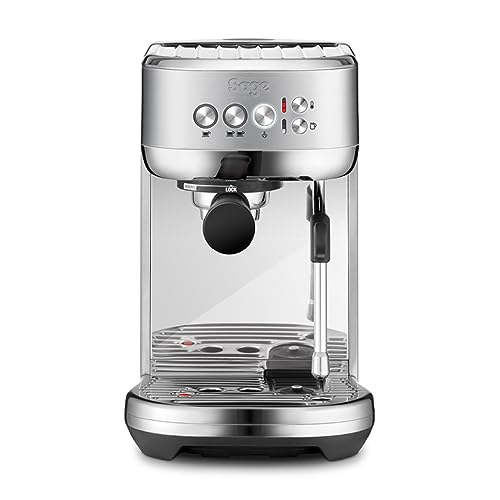What to Look For in a Commercial Espresso Machine
There are many things to consider when purchasing an espresso machine for commercial use. Your cafe's volume, intended service usage, and barista's expertise will determine which espresso machine is the best for your business.
A double boiler system gives the capability to brew and steam simultaneously. It also speeds up the recovery time between pulls. Proportional-integral-derivative (PID) temperature control manages on/off cycles for optimal boiler temperatures.
Productivity
A commercial espresso machine can handle a greater quantity of coffee than a home machine. Expecting a domestic espresso machine to work in a professional environment would be a recipe for disaster.
A high quality commercial machine can serve up to 100 cups of coffee per hour at peak times. best portable espresso maker is a huge benefit for busy workplaces, stopping employees from waiting for hours to get their coffee.
A coffee maker can help workers bond. Sometimes, teams of people make a habit of getting coffee for each other and this can help encourage collaboration and teamwork in the workplace. Having a dedicated space for coffee can also help new workers to feel at comfortably in the workplace, removing any barriers between them and senior employees.
Commercial espresso machines are available in various sizes to meet a variety of requirements. Some models are completely automatic and others are able to program espresso shots in advance so that the operator does not have to guess at the correct size of the shot. This is particularly important for companies with untrained baristas, as incorrect shots can greatly affect the flavor and intensity of brewed espresso. It is also recommended to buy commercial espresso machines that are made of ethically sourced materials that benefit the communities where coffee beans are harvested. This will ensure that the product is of good quality and reduce the negative impact to the environment.
Safety
Espresso machines are large, heavy pieces of equipment that can cost more than a brand new compact car. They're also designed to crank out a multitude of shots and drinks over the course of the day. Commercial espresso machines pose unique health and safety hazards for employees because of their sheer volume.
It's important to bear in mind that commercial espresso machines are likely to run on warm water, which could aid in the development of bacteria. A poorly maintained machine that hasn't been cleaned or descaled regularly can start to build up spent espresso, which may turn rancid and could potentially cause sickness if consumed by customers. Commercial espresso machines with a steam wand that is not sealed could allow bacteria to thrive in the milk the frothing process.
Take into consideration the type of beverage you will serve and the number of cups per hour can be served when selecting a commercial coffee machine. You'll want to look for an espresso machine that has automation features that will make it simpler to serve your customers your favorite coffee beverage. Look for a warranty which includes both parts and labor. This will ensure that any technical issues can be resolved quickly.
Energy Efficiency

The power requirements for commercial espresso machines are substantially more powerful than those used in home settings. This is due to the fact that professional espresso machines have more powerful frames and larger boilers to support the multiple group heads required for typical cafe production. These machines operate at a higher temperature and are generally located inside (such as in a cafe or restaurant) where the electronics can overheat.
The boiler of a commercial espresso machine provides heat and storage for pressurized drinking water supplied by an electric pump. This water is then used to brew and steaming espresso. The boiler is made up of a number of copper tubes that are heated by electric elements. When the brew level sensor senses that the water has reached its goal level the solenoid valve is opened to let the boiler fill with fresh water. The heating element is turned off.
There are four types of espresso machines. They are differentiated by the way they steam or brew by using TB (brewing-only), TX (twin-boilers) HX (double automated) and DA (double automated). TB and TX machines have stable brew temperatures, while DA can provide rapid steaming using only one boiler. HX machines are used in many cafes since they are the best in both brew and steam temperature.
Maintenance
Just like cars need routine tune-ups commercial espresso machines also require regular maintenance to function smoothly and efficiently. If you make the effort to keep your machine in top condition, it will provide you better tasting coffee and last longer.
It's a routine to clean your espresso machine, however you should be aware of the parts that need more thorough cleaning. There's likely to be residue from the coffee grounds and milk products inside the machine, which can disintegrate various components over time. Regular cleaning will keep your espresso machine in top condition.
The majority of commercial espresso machines require descaling every three months. This procedure requires more steps than regular cleaning, so be sure to read the manual to ensure that you're adhering to the instructions. The solution used to clean the water tank disintegrates the scale. You'll need a tank to finish this task. In certain models you may also require a container to be placed under the coffee spouts. Follow the directions for your particular model.
Another maintenance step includes changing the water filters. This is something that could be easily forgotten however it's essential to keep in mind so you don't end up with a build-up of mineral deposits. Examine for calcification. It is difficult to get rid of, in the spray head.
